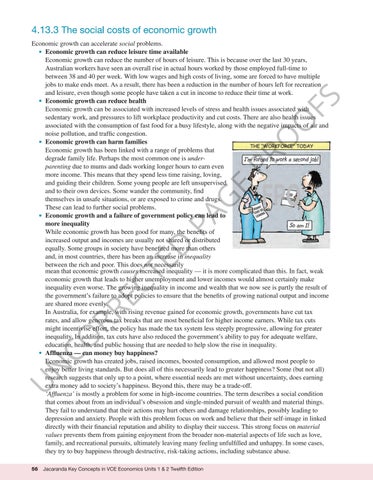“c04EconomicActivity_PrintPDF” — 2022/5/28 — 13:00 — page 56 — #56
4.13.3 The social costs of economic growth
U
N
CO RR EC
TE
D
PA
G
E
PR
O
O
FS
Economic growth can accelerate social problems. • Economic growth can reduce leisure time available Economic growth can reduce the number of hours of leisure. This is because over the last 30 years, Australian workers have seen an overall rise in actual hours worked by those employed full-time to between 38 and 40 per week. With low wages and high costs of living, some are forced to have multiple jobs to make ends meet. As a result, there has been a reduction in the number of hours left for recreation and leisure, even though some people have taken a cut in income to reduce their time at work. • Economic growth can reduce health Economic growth can be associated with increased levels of stress and health issues associated with sedentary work, and pressures to lift workplace productivity and cut costs. There are also health issues associated with the consumption of fast food for a busy lifestyle, along with the negative impacts of air and noise pollution, and traffic congestion. • Economic growth can harm families Economic growth has been linked with a range of problems that degrade family life. Perhaps the most common one is underparenting due to mums and dads working longer hours to earn even more income. This means that they spend less time raising, loving, and guiding their children. Some young people are left unsupervised and to their own devices. Some wander the community, find themselves in unsafe situations, or are exposed to crime and drugs. These can lead to further social problems. • Economic growth and a failure of government policy can lead to more inequality While economic growth has been good for many, the benefits of increased output and incomes are usually not shared or distributed equally. Some groups in society have benefited more than others and, in most countries, there has been an increase in inequality between the rich and poor. This does not necessarily mean that economic growth causes increased inequality — it is more complicated than this. In fact, weak economic growth that leads to higher unemployment and lower incomes would almost certainly make inequality even worse. The growing inequality in income and wealth that we now see is partly the result of the government’s failure to adopt policies to ensure that the benefits of growing national output and income are shared more evenly. In Australia, for example, with rising revenue gained for economic growth, governments have cut tax rates, and allow generous tax breaks that are most beneficial for higher income earners. While tax cuts might incentivise effort, the policy has made the tax system less steeply progressive, allowing for greater inequality. In addition, tax cuts have also reduced the government’s ability to pay for adequate welfare, education, health, and public housing that are needed to help slow the rise in inequality. • Affluenza — can money buy happiness? Economic growth has created jobs, raised incomes, boosted consumption, and allowed most people to enjoy better living standards. But does all of this necessarily lead to greater happiness? Some (but not all) research suggests that only up to a point, where essential needs are met without uncertainty, does earning extra money add to society’s happiness. Beyond this, there may be a trade-off. ‘Affluenza’ is mostly a problem for some in high-income countries. The term describes a social condition that comes about from an individual’s obsession and single-minded pursuit of wealth and material things. They fail to understand that their actions may hurt others and damage relationships, possibly leading to depression and anxiety. People with this problem focus on work and believe that their self-image in linked directly with their financial reputation and ability to display their success. This strong focus on material values prevents them from gaining enjoyment from the broader non-material aspects of life such as love, family, and recreational pursuits, ultimately leaving many feeling unfulfilled and unhappy. In some cases, they try to buy happiness through destructive, risk-taking actions, including substance abuse. 56
Jacaranda Key Concepts in VCE Economics Units 1 & 2 Twelfth Edition
FPO





















































